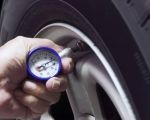Dealing with a Flat Tire on a Busy Highway: A Step-by-Step Guide
Imagine this: you're driving down a busy highway, the wind in your hair, music playing in the background, when suddenly you hear a strange sound. You look down and realize, it's your tire — flat. Panic sets in, but stay calm. Handling a flat tire on a busy highway doesn't have to be overwhelming. With the right knowledge and safety precautions, you can manage the situation with confidence.

MR. TIRE INC.
2078 New York Ave, Huntington Station, NY 11746, USA
1. Stay Calm and Assess the Situation
The first step in dealing with a flat tire on a busy highway is to stay calm. Many drivers panic at the sight of a flat, but panicking can make the situation worse. Instead, focus on safely getting your vehicle to the side of the road.
Start by checking your surroundings. If possible, signal and slowly pull over to a safe area. If you're driving on a multi-lane highway, aim for the shoulder. A clear, level spot is ideal for changing your tire. If the road is too busy, or you're unsure about the safety of pulling over, stay in your car and turn on your hazard lights.

MR. TIRE INC.
2078 New York Ave, Huntington Station, NY 11746, USA
2. Secure Your Vehicle
Before you even think about changing the tire, ensure that your vehicle is secure. Engage your parking brake to prevent the car from rolling. If you're on a busy highway, it's best to keep the engine running to stay visible to passing drivers. You should also place reflective warning triangles or cones around your car if you have them, creating a safe perimeter.
It's essential to wear your seatbelt while you assess the situation, and make sure all passengers are safely out of the vehicle if it's safe to do so. If the traffic is too heavy, it's advisable for everyone to stay inside the vehicle until emergency assistance arrives.
3. Gather the Necessary Tools
If you decide to change the flat tire yourself, make sure you have the necessary tools. Typically, you will need:
- Jack
- Lug wrench
- Spare tire
- Wheel wedges
- Flashlight (if it's dark)
Take your time to gather these tools and make sure you are in a stable position. Avoid rushing, as hasty actions can lead to mistakes and potential injuries.
4. Loosen the Lug Nuts
Once you’ve secured the vehicle and gathered your tools, the next step is to loosen the lug nuts on the flat tire. Remember, it’s important to do this before you lift the car with the jack. Use the lug wrench to turn the nuts counterclockwise, but don’t remove them completely just yet.
If the lug nuts are too tight, it may help to use your body weight or apply additional force. Be sure to break the seal on the nuts but stop short of fully removing them until the vehicle is raised.
5. Use the Jack to Lift the Vehicle
Now it's time to use the jack to lift the vehicle. Place the jack underneath the vehicle's frame, near the flat tire. If you're unsure of where to place the jack, consult your car’s manual for instructions. Carefully lift the car until the flat tire is off the ground, but don't lift it too high. The goal is to remove the flat tire while keeping the vehicle stable.
Once the car is securely lifted, double-check that it’s stable before proceeding to remove the lug nuts completely and take off the flat tire.
6. Replace the Flat Tire with the Spare
Now, remove the flat tire by pulling it straight off the wheel. Take your spare tire and align it with the wheel bolts. Gently slide it onto the hub, ensuring it's properly secured. Once in place, replace the lug nuts and tighten them by hand.
Using the lug wrench, tighten the nuts in a star pattern to ensure an even fit. Do not fully tighten the lug nuts yet; this step will come later. Lower the car back to the ground using the jack, and once the car is stable, fully tighten the lug nuts.
7. Final Checks and Safety Considerations
After securing the spare tire, lower your car to the ground completely, remove the jack, and double-check that all the lug nuts are tight. It's also a good idea to check the pressure of your spare tire to ensure it's safe to drive on.
Before driving away, make sure everything is packed up. Place the flat tire and tools back into your car and dispose of the old tire responsibly. If you’re not able to fix the tire or feel unsafe doing so, consider calling for roadside assistance to ensure you're not taking unnecessary risks.
Conclusion: When to Call for Help
Although changing a tire on a busy highway can be an intimidating experience, following these steps and staying calm can help ensure a safe resolution. In some cases, such as when the vehicle is in a dangerous location or the driver lacks the experience or tools, it may be best to call for professional roadside assistance. However, knowing how to handle a flat tire on your own can give you peace of mind and help you save time and money in emergency situations.
If you're unsure about tackling this task yourself, don’t hesitate to call for help from a professional towing or roadside service. They will handle the situation with the expertise and tools necessary to get you back on the road safely.




























